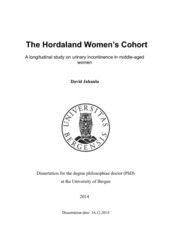| dc.description.abstract | Urinary incontinence (UI) is a prevalent problem among middle-aged women, and many epidemiological studies have investigated this problem. Most of these studies are cross-sectional and only few longitudinal studies have been conducted. Thus, the knowledge about incidence, remission and natural history of UI is scarce. The aim of that present dissertation was to answer major epidemiological questions about incidence, progress and remission of UI in middle-aged women. The Hordaland Women’s Cohort was established in 1997 and designed as a prospective longitudinal study for 15 years. The source population was from Hordaland Health Study (HUSK), which was a joint epidemiological research project and a part of national health project called Cohort of Norway (CONOR). HUSK invited all individuals in Hordaland County born between 1953-57, and among 14300 women in Hordaland, almost 9900 (70%) participated in HUSK. We took a one-fifth random sample of female HUSK participants and 2230 women consented to take part in the Women’s Cohort. In 2007 the Cohort reached a ten-year follow up with six checkpoints and the present dissertation is based on the analyses of data for this period of the Cohort. In the first sub-study (Paper I), the data from source (HUSK) population was used to compare the basic demographic data and urologic characteristics between the women who participated in the Cohort and rest of the women in HUSK. For demographic data, 2230 women in the Cohort were compared with 7746 women in HUSK, who were not selected for the Cohort. For urologic characteristics, we used a HUSK subquestionnaire with 5320 participants. Of these, 1920 were in the Cohort and we compared their urological characteristics with those of the rest of the women (n=3400). The results demographic data showed a very high similarity for demographic data. The only significant differences were observed for higher education (p=0.001) and higher annual family income (p=0.018) among the women in the Cohort. Analyzing data for urinary conditions showed few statistical differences between women in the Cohort and the rest of the women; they had somewhat more UI (p=0.040), more stress UI (p=0.048) and less amount of leakage (p=0.015) in the Cohort participants. Prevalence rate of any UI was 28.9% in the Cohort and 24.8% in the rest of women in HUSK. This paper also described the research methodology in details with intention of using it as reference for any further data analysis from the Cohort. The second sub-study (Paper II) explored the prevalence, incidence and remission of UI. In this paper the possibility of an early prevalence peak in middle-aged women was investigated. We first used all data from the Cohort, which was gathered during ten years in six waves, to analyze the prevalence curve of UI. Furthermore, for more detailed analyses of prevalence, incidence and remission, data from the women who answered all six questionnaires were used. We sorted data in terms of age with eight groups in the age span of 41-55 years. Definition of UI was based on the results from the Incontinence Severity Index (ISI) and women with an ISI of more than 0 were defined as having incontinence. Women with an ISI equal to 3 or more, who reported their UI to be bothersome, were defined as having significant UI. According to our data, the prevalence of any UI in women aged 41-42 year was about 37% and increased gradually up to 50% in the age of 51-52 years, after which it started to decrease gradually. The changing patterns for incidence and remission were the same until age 51-52, but then the incidence started to decrease while the remission was increasing, which could have caused the peak in the prevalence of UI. Stress UI was the major type and most cases of UI were of low severity. Over the observation period, while the proportion of mixed UI increased by age, the proportion of stress UI remained relatively stable and the proportion of urgency UI slightly varied between aged groups. Regarding type shift, proportion of moderate UI remained relatively stable, while slight UI decreased and severe/very severe UI increased by age. The main aim of the third sub-study (Paper III) was to investigate the natural history of UI with focus on finding the new-onset UI and its changes in types and severity. First we defined continent women in the baseline by using the same definition of UI as in Paper II. We followed them wave by wave during 10 years and 5 checkpoints. Almost half of them reported to have UI, at least once during 10 years. The types of new-onset UI by type were distributed as: 49.8% stress, 18.3% urgency and 20.3% mixed UI. By severity, 89.3% of women started with slight UI, none of them reported severe UI in the first report. In follow up of women for 2 waves after the new-onset UI, one-third of them had persistent UI, the type and severity was mainly stress UI with slight severity, with a low tendency for shifting the type or severity. We also suggest out that mixed UI is not necessarily the final stage of UI. | en_US |

